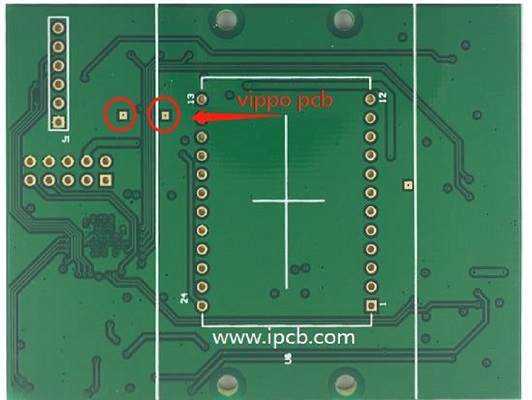With the widespread use of fine-pitch devices and smaller PCBs, there has been the emergence of through-hole structures within pads. The through-hole inside the pad is the through-hole inside the pad. Firstly, drilling, electroplating or flash plating, filling with epoxy resin or copper epoxy resin and flattening to make the surface flat for easy assembly. The advantages of this technology are tighter packaging of components, improved thermal management, and the elimination of parasitic inductance and capacitance, as these through holes reduce the length of the signal path.

VIPPO
As the product design wiring density gradually increases, HDI boards (High- Density Inverters) begin to appear, and micro blind buried hole technology begins to be applied. First order, second order, third order, or even any order, the higher the order, the higher the technical difficulty, including through-hole technology.
A through hole is a micro conductive path drilled into a PCB, used to establish electrical connections between different layers. Basically, through holes are vertical wiring in a PCB. The increase in signal speed, circuit board component density, and PCB thickness of solder pads or solder holes on pads lead to the realization of internal solder pads. CAD design engineers implement VIPPO and traditional through-hole structures to achieve distributed linearity and signal integrity requirements.
The process of making vias can be divided into two parts: the first half is called "drilling", and the second half is called "plug hole".There are various ways to handle holes, including through holes, blind holes, buried holes, back drilling, etc. Among them, through holes are generally used for copper plating and plug-hole processes, including full plug, half plug, VIPPO, and SKIPPO.
If it is necessary to drill holes and paste electronic components on the pad, VIPPO (Via in Pad Plated over) or SKIPPO (Skip Via in Pad Plated over) must be used. VIPPO and SKIPPO are generally used on BGA pads.
Among them, VIPPO's through hole can be a through hole or a blind hole; The via of SKIPPO specifically refers to blind holes from the top layer to the third layer, and from the bottom layer (n) to the n-2 layer.
The diameter of VIPPO should not exceed 0.5mm, otherwise, the solder paste during SMT may flow into the hole, or during heating, the flux will flow into the hole, thus generating gas, resulting in insufficient connection strength. Virtual welding occurs between the device and the pad.
The electroplated pad through hole (VIPPO) is the same as the pad through the hole, except that VIPPO is located within the SMT pad, not a regular pad, such as a blind hole pad. In addition, VIPPO can also be used for back drilling (controlling depth drilling) to remove excess metal from the holes below the inner end connection.
In PCB design, electroplating (VIPPO) technology, also known as via electroplating (POFV), is widely used in small PCBs with limited BGA space. The via in the padding process allows the via to be electroplated and hidden under the BGA pad. It requires PCB manufacturers to fill the through-hole with epoxy resin and then copper plating on the through-hole to make it almost invisible.
The use of POFV technology can greatly improve the efficiency of PCB design engineers, as vias take up too much space during design, leading to increased difficulty in wiring. And the through hole is punched into the solder pad, giving a portion of space for design engineers to have more space for wiring. The hole-in tray process makes the PCB process three-dimensional, effectively saving wiring space inside the board, and adapting to the development needs of the electronics industry. In general, using a vacuum plug-hole machine to plug holes and a ceramic grinder to polish them can make the quality of PCB plug holes more stable.
The advantages of VIPPO technology
1. The holes on the solder pad can improve the tracking route.
2. The holes on the cushion help dissipate heat.
3. The holes on the solder pads can help reduce the inductance of high-frequency PCB boards.
4. The holes in the gasket provide a flat surface for the component.
VIPPO differs from regular vias in that it wears a copper cap that is flush with the solder pad. VIPPO is mainly used in high-end products such as communication/servers.